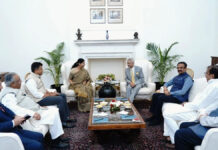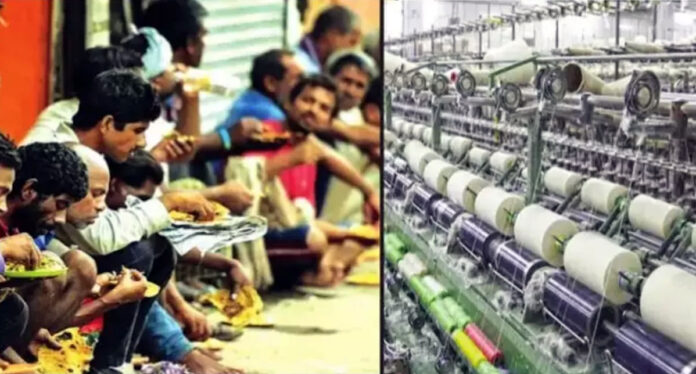AGENCY
NEW DELHI, Mar 30
Economic activities have taken the centre-stage of human life. Everyone has to earn his own money to sustain – to obtain food, shelter, education, health and entertainment. There is no scarcity of food and other materials on earth; but access is restricted. Only those who have money can obtain these essentials and luxuries. It is now virtually the mandate of the capitalist society that anyone not possessing money or wealth has to do hard physical labour for survival.
He has to use a good quantity of muscle power, nerves and brains daily to earn money. It is presumed that poor illiterate people will do backbreaking jobs 365 days a year, that too for paltry sums. Their wives and children too will have to work throughout the year. Their bodies are their only assets. A poor person, even if he works hard, may still remain poor under the present economic system. Poverty has become an integral part of society. Hungry men need money at any cost to buy food. It is presumed that poor families will work as unskilled labour in industries. The rise of capitalism coupled with rapid acceleration of industrialisation created the ‘labour force’.
Capitalism needs plenty of labour at the cheapest cost. Poverty feeds capitalism well. Patrick Colquahoun (1745-1820), a powerful Scottish merchant, saw poverty as an essential precondition for industrialization. In his words: “Poverty is therefore a most necessary and indispensable ingredient in society, without which nations and communities could not exist in a state of civilization. It is the lot of man. It is the source of wealth, since without poverty, there could be no labour, there could be no riches.”
Labour cost in industries is determined by prevailing labour market prices and not by contributions made by each individual labour to production. So, industrialists have the advantage in determining wages in their favour in a developing economy like India. Some argue that the capitalist system inherently involves exploitation of labour, where workers are paid less than the value they produce, leading to poverty and precarious living conditions. Industry workers do not possess bargaining power over their wages as unemployment or underemployment is rampant.
The situation has led them into fierce competition among themselves. Collective bargaining belongs to the past. They have to accept meagre wages and poor working conditions along with long working hours. Further, the benefit of increase in productivity does not go back to the industry workers. Even real wages remain stagnant in India for a long period of time. The sector wise wage growth of workers, CAGR 2019-2023, indicates maximum growth of 5.4 per cent in the FMCG sector which is even lower than the 5- year average CPI index of 5.7 per cent. Income levels of workers in some sectors have increased but they remain vulnerable.
The conditions of workers in the informal sector, which comprises 93 per cent of the workforce, are more dismal. The Indus Valley Annual Report 2025 tells us that 100 crore Indians have no money to spend on nonessential goods. The report suggests only the top 10 per cent of the population has enough discretionary money to spend. This implies a majority of Indians, including workers, farmers, daily wage-earners and gig workers, do not have sufficient monetary strength. It is reported that the products aimed for mass consumption have lost market share.
The consuming class is not widening but is deepening implying the rich getting richer.
The Report also suggests that the brands are shifting focus from capturing mass market to concentrating on premium products for premium customers. Stark inequality and extreme concentration of wealth in a few hands have pushed the majority of the population to the brink of economic adversity leading to intolerable hardships. They are marginally above the line defining absolute poverty and may again fall back into poverty. This line of absolute poverty is therefore a blurred one.
The World Bank report suggests 13 crore people were in extreme poverty in India in 2024 at an income of Rs 181 (USD 2.15) per day. With higher poverty standards, there are more people living under Rs 576 (USD 6.85) per day in 2024 than in 1990. Even with this higher income per day no family can sustain with dignity today. The World Bank suggests that enabling the poor to benefit more from economic growth will require better-functioning labour markets. Capitalism sometimes emerges as the leader of society and advises unexpectedly that workers should not waste time and should work every day including weekly off days.
Some industry tycoons plead for 70 to 90 hour work weeks. But the considered opinion is not available about the gulf of difference between the median remuneration earned by an average worker and that of a CEO in the same corporate house. Deep deliberations among a wide swathe of society about the whole spectrum of glitches will result in policy decisions. Stray comments on selected individual issues are not the need of the hour. Capitalism remains indifferent to social causes.
It does not help in creating a new and improved social structure that will allow a majority of people to live better lives. Poverty and inequality are the two major social evils that contribute immensely to sustain capitalism. On the other hand, it is the inherent design of capitalism to endure poverty and inequality for its own existence. “In 1771 the agriculturist Arthur Young noted that”everyone but an idiot knows that the lower classes must be kept poor, or they will never be industrious” (Jason Hickel: ‘Less is More’).
Capitalism always vies for excess production to generate excess profit. If such excess production is reduced then the people can be liberated from the toil of unnecessary labour. Income and wealth can be distributed less inequitably and more fairly. But capitalism will not permit slowing down production. But still capitalism has no immediate and foreseeable alternative even if it is considered unfavourable today by a majority of people. So, the conditions of labourers and thereby of poverty will not change significantly in the near future. The World Bank observed that global poverty reduction has slowed to a near standstill with the current decade set to be a lost decade.
There has been a complete and continuous disconnect between the interests of the owners and that of the workers. Treating employees with greater dignity and respect ultimately serves everyone better. Situations where workers’ interests are not being honoured and not served properly have clearly led to an increase in poverty. The workers would have to replenish the energy they expend for production daily. They have to take sufficient food and rest to re-energize themselves.
Their mental condition should also remain unruffled by their economic conditions in order to deploy their full potential for production. The State, institutions and policy makers should take care of these labourers and their families who are contributors to the GDP growth of the country often at the cost of their own well-being. Policies should be designed to regulate the labour market and ensure higher wages. Labour income growth must be prioritized to reduce vulnerability. This will be a major step towards eradication of large-scale poverty. Poverty, labour conditions and capitalism in India are deeply intertwined.
(The writer, a cost accountant, was General Manager of a state power utility.)



























